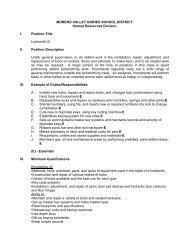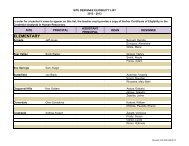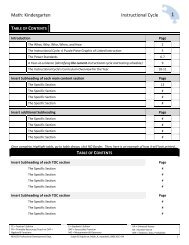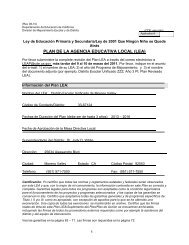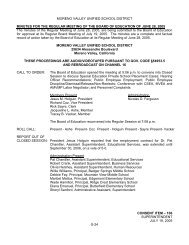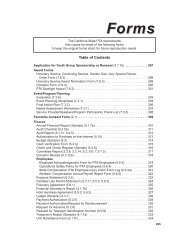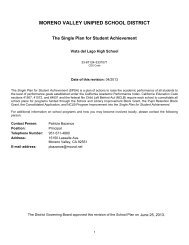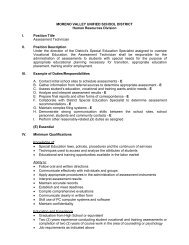October 2012 - Moreno Valley Unified School District
October 2012 - Moreno Valley Unified School District
October 2012 - Moreno Valley Unified School District
You also want an ePaper? Increase the reach of your titles
YUMPU automatically turns print PDFs into web optimized ePapers that Google loves.
P A G E 9Students sit on the floor, attentivelylistening as the storyteller readsaloud. Several hands shoot up,without further prompting. Studentstook on the various roles in thestory, dramatizing what they werereading and now they are talkingabout how acting out the storyhelped them feel the narrative andunderstand it better. Thoughtfulanswers to questions are given,prompting more discussion.This is not just a teacher’s dream,but a real DREAM — theDeveloping Reading Education withArts Methods (DREAM) project.Funded through the Arts inEducation Model Development andDissemination Grant Program(AEMDD) in OII, the four-yearproject uses visual arts and theaterto teach students about reading andto improve how they read.DREAM is headed by the SanDiego County Office ofEducation, in partnership with theNorth County ProfessionalDevelopment Federation andCalifornia State University SanMarcos. It consists of professionaldevelopment of third- and fourthgradeteachers, along with a oneweeksummer institute and inclassroompairings of teachers andteaching artists.The teaching artists and summerinstitute help teachers learn anddevelop the ability to use visual artsand theater activities to improvestudents’ reading and language artsskills. “It is so great to see teacherslearn new things, embrace newideas, and realize that they can dothis,” says Patti Saraniero, aDREAM project researcher.Results of the DREAM project werepresented at the AmericanEducational Research Association'sAnnual Meeting in April 2011. Year-end state tests demonstrated gainsin reading comprehension,vocabulary acquisition, andcharacter analysis via artsintegration. The AEMDD projectmeasured student progress bydividing teachers’ classrooms intothree categories: teachers who onlyattended the summer institute,teachers who attended the summerinstitute and received weeklycoaching by teaching artists, andteachers who did not receive anytraining or coaching.Student progress was measuredusing the California Standards Testfor English Language Arts – bothbefore and after participation in theDREAM project. Those studentstaught by teachers who had notreceived any training averaged anincrease of 25 points over the year.Students in classrooms with theteachers who only attended thesummer institute had an average 51-point improvement. The students inclassrooms with teachers who bothattended the institute and received in-class coaching averaged animprovement of 87 points.Because of the in-classroommentoring from teaching artists andreceiving support in improving theirskills, teachers who were coachedused arts integration morefrequently in their instruction. Theyalso were more likely to implementarts-integrated lessons based on theCalifornia visual and performingarts standards, and they felt moreconfident in integrating the arts withother subjects such as Englishlanguage arts in their classrooms.The benefits of the DREAM projectgo beyond what can be measured bytest scores, according to MerrylGoldberg, DREAM project artisticdirector. “The arts teach creativethinking, innovative thinking,critical thinking, teach how to thinkoutside the box, how to problemsolve, (and) how to work withothers,” she noted. “These are skillsthat are fundamental to what weneed in the 21 st century.”




